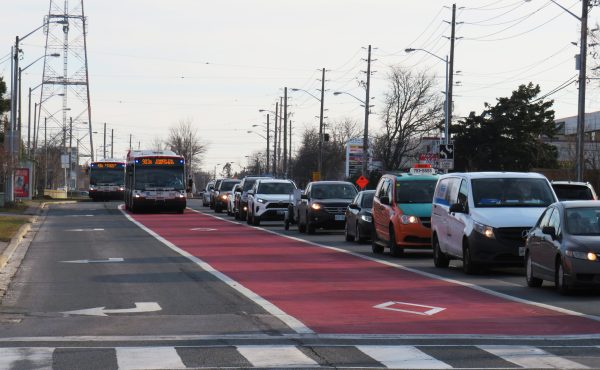The Sunday Star had a few articles of note (since Tuesday is the best time to reflect on the Sunday paper):
Why not shop the better way? Andrew Chung wonders why the TTC isn’t looking at retail to inject more revenue into the system.
However, as a sort of counter-point, Glen Murray provides a cautionary tale in Burning the furniture to heat the house by looking at the TTC’s plan to sell of excess land. Murray writes that the last time the TTC had an opportunity to deal with a development adjacent to a subway station, the results were less than stellar:
The construction of the Four Seasons Centre — Toronto’s first opera house — presented the kind of economic opportunity that mayors dream of: a dynamic new cultural facility between two very busy stand-alone subway stations, next to two of Canada’s largest hotels replete with convention facilities, a block from two major department stores and the largest downtown mall in Canada, with City Hall nearby and on the busiest streetcar route to boot.
Here was a golden opportunity for the TTC to build connections, realize new developments and, under dynamic leadership from the city, to forge a new cultural tourism district from the build-out of these subways and new connections between all these top-class cultural and tourism facilities.
What if we had rebuilt the Osgoode station so that it transitioned seamlessly into underground shops, then stepped up into dynamic streetscapes, that in turn created an energy and excitement connecting the opera house, the Hilton and Sheraton Hotels, the Bay and Nathan Phillips Square into a great avenue of culture and food?
What if we had lined the streets with public art and great street furniture, opening up opportunities for exciting restaurants and shops and converted the small north-south streets into a pedestrian mall?
This would have triggered an explosion of cultural experience into the street, enhancing the value of the land and buildings, and expanding the city’s tax base.
In other news at opera house scale, Spacing Votes columnist John Lorinc writes an open letter — A modest proposal — to David Crombie, a man in search of a place for Toronto’s museum. Lorinc suggests looking to Maple Leaf Gardens and doing something like the Tate Modern did when it moved into the former Bankside power station in London (arguably now the greatest place on Earth):
We could do the same with the Gardens — a 76-year-old barn redolent of the gritty, working-class ethic that characterized early 20th-century Toronto. And though we mustn’t overlook the victims of the abuse scandal during the Harold Ballard years, the Gardens had an electrifying impact on hundreds of thousands of kids who went there to see their first NHL match. I can vividly remember the purely aesthetic experience of first setting foot in that cathedral-like space, with its brilliant collage of colours and noises.
To me, it’s also revealing that the late media mogul Ken Thomson was both a major fine-art collector and a dedicated hockey fan who frequented the Gardens. The building is evidently a place that has resonated very broadly across our city’s culture.
 This modest proposal is sure to satisfy most folks worried about the future of the Gardens. Nobody really worried about the demise of Terminal Two at Pearson in same way — but just as we remembered it a few weeks ago, Bill Taylor gives the old concrete beast a loving send off:
This modest proposal is sure to satisfy most folks worried about the future of the Gardens. Nobody really worried about the demise of Terminal Two at Pearson in same way — but just as we remembered it a few weeks ago, Bill Taylor gives the old concrete beast a loving send off:
It certainly looked like a warehouse. Perhaps whoever masterminded it had had an unhappy childhood and grew up hating people. Whereas today’s buildings at Pearson International are light and airy with huge windows looking out over the airport, Terminal 2 was deliberately made unfriendly to visitors. It was about a kilometre long and had no windows.
The pigs did get to ride moving sidewalks though, and that was something, back in ’72.
(Top illustration via The Star of early 1990s retail proposal. Note the kid with the ballons and #99 jersey — we suppose more believable than a Wendel Clark or Todd Gill shirt)




6 comments
Andrew Chung’s proposal has one critical flaw: it assumes that just by designing a retail space as an integral part of a subway station, hordes of shoppers will descend on the gleeful merchants. Things don’t work like that.
Leaving aside the nimby issues of servicing a significant retail presence in the middle of a low-density residential neighbourhood, the point about any retail complex is that it has to be in a location people want to go to. That’s how a site generates traffic.
Shops that are largely dependent on transit access are rare. The Eaton Centre is an example, but it is surrounded by other traffic generators — offices, Ryerson University, and a growing downtown population — who have some other reason to be in the neighbourhood.
Imagine Yorkdale or Fairview as transit-only destinations. The subway alone is not enough to get people to either site because most are coming from a diverse set of origins where transit service is not spectacular at the best of times. Indeed, Fairview’s biggest concern about Don Mills Station was that they not lose any parking space as a side effect of the subway construction.
People shopping by transit need to either carry away their purchases, or have inexpensive delivery options. I am always amused by references to Bessarion as the IKEA station given the trek over hill and dale needed to reach the store from the subway, a trek that will only be more difficult as construction ramps up at this site.
Looking at the proposed York U / Vaughan subway, I will be astounded to see much retail presence at any stop other than York U itself. One might wonder if York wants competition for rental revenue they get today from shops within their own buildings. We might see something at Finch West, but that’s as much a question of the nearby landowners’ intent as the TTC’s.
Yes, the situation at Osgoode with the Opera House is very, very sad. Remember that this project started in the Lastman era, and the TTC was desperate to avoid any project unless someone else paid for it. The Opera House itself suffered from underfunding (hence some of those blank exterior walls), and was not about to load the cost of a major subway connection / retail plaza onto their cost base. Originally, a private partner was to build a condo tower at the York Street end, but that scheme died, and with it some of the extra money that might have gone to more extensive facilities.
Finally, the TTC has no authority, unlike agencies elsewhere, to engage in land assembly and development as a way of cross-funding transit expansion. This isn’t a TTC issue, it is one of Provincial law that prevents cities from using their expropriation powers to excess.
1) I believe it’s a bit too late to “save” MLG, as Loblaws bought it a couple years ago… but at the time I wondered why MLSE didn’t keep it… it would be awesome to watch the Marlies play there – way easier to get to than the Ricoh Coliseum.
2) Terminal 2 WAS a freight terminal originally… it was converted into passenger usage because Terminal One (the original) couldn’t handle the crowds.
ps. here’s a Wikipedia link to information about Terminal 2 as a freight terminal. I’m rather astounded that Bill Taylor / thestar would not do a bit of research before publishing a column condemning the architecture. The article reads like something from the Sun.
^I don’t know, I think it was a light-hearted review of T2.
As for MLG, Lorinc does say that perhaps the best thing to happen is that it was bought up by Loblaws, as the Weston family has a history of doing good philanthropic things, and that the Loblaws expansion may be stalled.
re: lightheartedness… then I retract my criticism. 🙂
Thanks Shawn!
re: the Opera House.
Forget all yr grand plans of underground shopping promenades, bustling outdoor avenues and explosions of cultural experience. At this point, SEVEN MONTHS after the Four Seasons Centre’s opening, the stairway from Osgoode to the hall is STILL not open. NOT GOOD ENOUGH!!!!!!